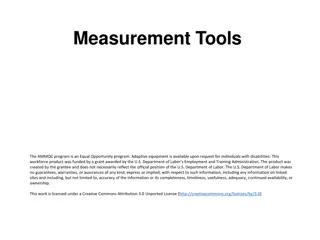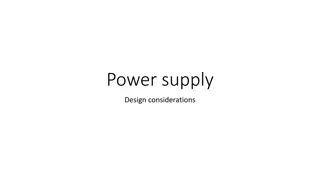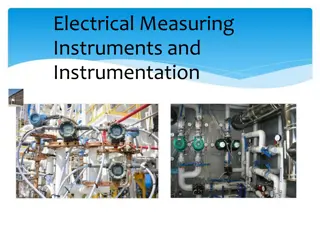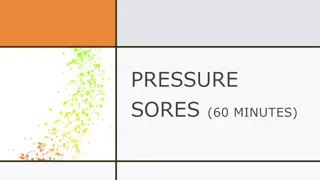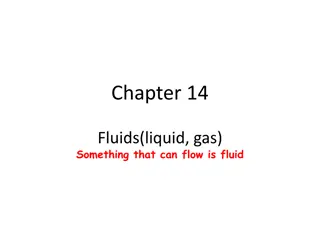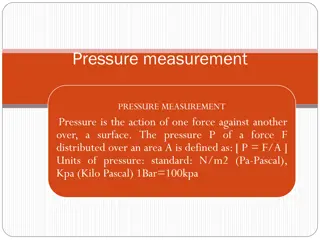Understanding Anaesthetic Machine Components: Pressure Gauges, Regulators, and Flowmeters
Anaesthetists rely on pressure gauges, regulators, and flowmeters in anaesthetic machines for safe administration of gases. Pressure gauges monitor oxygen, nitrous oxide, and medical air levels, each uniquely calibrated. Differentiating oxygen and nitrous oxide gauges is crucial due to storage differences. Safety measures include proper gauge use, damage prevention, and gas venting mechanisms in case of malfunctions, safeguarding the anaesthetic machine components.
Download Presentation

Please find below an Image/Link to download the presentation.
The content on the website is provided AS IS for your information and personal use only. It may not be sold, licensed, or shared on other websites without obtaining consent from the author. Download presentation by click this link. If you encounter any issues during the download, it is possible that the publisher has removed the file from their server.
E N D
Presentation Transcript
Pressure Regulator, Pressure Gauge, Flowmeters Description: Anaesthetists use the anaesthetic machine daily, both inside and outside the operating theatre. This session explores some of the main components of the anaesthetic machine, namely pressure gauges, regulators and flowmeters, looking at their functions and examining safety issues in their design.
Summary session Objectives: Identify the key features and functionality of pressure gauges, regulators and flow restrictors components of the anaesthetic machine Recognize the components, basic designs and functionality of the anaesthetic machine flowmeters and demonstrate an awareness of their safety features Define the anti hypoxic features in flowmeter design
Pressure gauges The pressure in the cylinders and pipelines are measured by pressure gauges. There are usually pressure gauges for oxygen, nitrous oxide and medical air, delivered from cylinders and/or pipelines. They are mounted in a front facing panel on the anaesthetic machine. Some modern anaesthetic machine designs have a digital display of the gas supply pressures. Each pressure gauge is labeled, color coded and calibrated for a particular gas or vapour.
Oxygen and nitrous oxide pressure gauges Oxygen and nitrous oxide gauges differ in important aspects, as do gauges used for pipeline and cylinder supply. Oxygen: In the case of oxygen, the pressure measured indicate the contents available in the cylinder. This is because oxygen is stored as a gas and obeys Boyles gas law. Pressure x Volume = Constant
Oxygen and nitrous oxide pressure gauges Nitrous oxide: In the case of nitrous oxide cylinder, the content is stored as a liquid and vapour. Gas law do not apply in the case of this cylinder.
Oxygen and nitrous oxide pressure gauges Cylinder and pipeline gauges: A pressure gauge designed for cylinder should not be used to measure pipeline pressure and vice versa. Wrongly connected gauges can lead to inaccuracies and/or damage to the pressure gauge. As a safety feature, in case of failure or malfunction, the gauge is designed to vent escaping gas through the back of the casing, this feature protects the other parts of the anaesthesia machine from the potential damage that high pressure gases might cause. As an additional safety feature, the face of the pressure gauge is made of heavy glass.
Pressure regulators Pressure regulators are devices that convert variable, high pressures to constant lower output pressures. They are usually positioned at the back of the anaesthetic machine or under its tray. The reason why pressure regulators are used in anaesthetic practice are: Variable cylinder pressure Maintaining constant flow Pressure surging Gas leaks
Pressure regulators Variable cylinder pressure: As gases are stored under high pressure in cylinders, regulators are necessary to reduce the variable cylinder pressure to a constant safe operating pressure of about 400KPa. Maintaining constant flow: As the gas in the cylinder is used up, the temperature and pressure of the cylinder contents decrease. Regulator allow for a constant flow to be maintained in spite of this. Pressure surging: Regulators are positioned between the cylinders and the rest of the anaesthetic machine. This protects the low pressure components of the anaesthetic machine against pressure surges. Gas leaks: The use of pressure regulators allows low pressure piping and connectors to be used in the machine. This means that the machines pipe work is safe and easy to use, making the consequences of any gas leak much less serious. In the event of regulator failure, for safety purposes, relieve valves (usually set at 700KPa ) are fitted downstream of the regulators and allow gas to escape. Should such a failure occur, the high flow rate of escaping gas will produce a hissing sound loud enough to alert the anaesthetist to the problem.
Flow restrictors Pressure regulators are not the only means by which gas is supplied. When pipeline supply is used (at a pressure of 400KPa), flow restrictors are used instead. Flow restrictors are simple constrictions between the pipeline supply and the rest of the anaesthetic machine. Flow restrictors function in a similar way to pressure regulators. They significantly reduced the pressure while maintaining a constant flow rate, despite any changes in pipeline pressure that might occur.in this way, lower pressures of 100 200KPa can be achieved. Flow restrictors are used on the pipeline supply instead of pressure regulators because pipeline supply pressure is not as high and variable as that delivered by cylinders.
Flow control (Needle) Valves Flow control needle valves are designed to control the flow through the flowmeters by manual adjustment. They are positioned at the base of the associated flowmeter tube. Increasing the flow of a gas is achieved by turning the valve in an anticlockwise direction. Flow control knobs are labelled and color coded. The oxygen control knob is designed to have a different shape in order to allow identification and recognition by touch as shown. The oxygen knob is normally designed to be larger than the other types with pronounced ridges to allow easier recognition. In some designs, the oxygen knob also has a longer stem.
Flowmeters The flowmeters in anaesthetic machine measure a flow rate of a gas passing through them. Each flowmeter is individually calibrated for each gas. Calibration occurs at room temperature and atmospheric pressure at sea level. flowmeters have an accuracy of about +/- 2.5%. Units are calibrated as L/min for flows above one L/min. for flows below that, measurement is shown in increments of 100ml/min. this allows for more accurate flow measurements when a low - flow breathing system is used. The flow of the gas is controlled by the flow control (needle) valve. The gas then flows in to a tapered transparent plastic or glass tube that is wider at the top than the bottom. A light weight rotating bobbin or ball is used to measure the flow. The bobbin stops at either ends of the tube ensure that the bobbin is always visible to the operator at extreams of flow.
The bobbin The bobbin is held floating within the tube by the gas flow passing around it. The higher the flow rate, the higher the bobbin rises within the tube. The effect of gravity on the bobbin is counteracted by the gas flow. A constant pressure difference across the bobbin exists as it floats.
The bobbin Gas flow physics: At low flow rates, the clearance is longer and narrower, thus acting as a tube. Under these circumstances, the flow is laminar and a function of gas viscosity (Poiseuilles law). At high flow rates whoever, the clearance is shorter and wider, thus acting as an orifice. In this instance, the flow is turbulent and a function of gas density.
Flowmeter reading and functionality The reading of flowmeter is taken from a top of the bobbin. When a ball is used, the reading is generally taken from the midpoint of the ball. This is important for accurate measurements of flow, especially when using very low flow rates during closed circle or low flow anaesthesia. Note: the arrow pointing to the reading on the flowmeter.
Bobbin design In flowmeter different designs of bobbin or balls are used. Most modern anaesthetic machines use a skirted bobbin with a dot to facilitate easy and accurate measurements of flows even when the flow rate is very low. the tops of bobbin 3 and 4 are shown with slits (flutes) cut into the top. Gas flowing through these slits causes the bobbins to rotate inside the flowmeter tube. The bobbins rotation and features such as the dot on bobbin 3 indicate to the operator that the bobbin is floating in the gas flow and not stuck inside the tube. Thus, an accurate reading of gas flow can be obtained. 1. Ball design 2. Non rotating H float design 3. Skirted design 4. Non skirted design
Low flows When very low flows are required, e.g. in the circle breathing system during closed circle or low flow anaesthesia, an arrangement of two flowmeters in series is used. One thinner flowmeter reads a maximum of one L/min. allowing fine and accurate adjustment of the flow. The calibrations used in this flowmeter is in 50 ml increments. The other flowmeter reads up to a maximum of 10 15L/min (depending on the gas) with calibrations in 500 ml increments. One flow control knob per gas is needed for both flowmeters. Note: the different calibrations of the tubes: 50 ml for the thinner one and 500 ml for the other.
Safety features in flowmeter design anti hypoxic features When working with flowmeters, it is important to note that the oxygen control knob is situated to the left (in the UK) whereas in the USA and Canada, it is situated to the right. This may be due to historical reasons that is a cause of a potential problem if there is a crack in adjacent downward flowmeter that may result in a hypoxic mixture. In such cases, the oxygen will flow via the least resistant path, i.e. the cracked flowmeter, so potentially producing a hypoxic mixture. To avoid this issue, oxygen is the last gas to be added to the mixture delivered to the back bar. With this design, the oxygen flowmeter is returned on the left but oxygen is added last to the mixture.
Safety features in flowmeter design anti hypoxic features The European standard for anaesthetic machines requires them to have the means to prevent the delivery of a gas mixture with an oxygen concentration bellow 25%. In the modern anaesthetic machines it is impossible for nitrous oxide to be delivered without the addition of fixed percentage of oxygen. This is achieved by using interactive oxygen and nitrous oxide controls. This helps to prevent the possibility of delivering a hypoxic mixture to the patient. Oxygen and nitrous oxide have separate flow control knobs, but they are linked mechanically or pneumatically, so that it is impossible to deliver less than a specified oxygen concentration (typically 25% - 30% oxygen)
Safety features in flowmeter design Quantiflex anaesthetic machine The Quantiflex anaesthetic machine has two flowmeters, one for oxygen and one for nitrous oxide, with one control knob for both flowmeters. The oxygen flowmeter is situated to the right, whereas the nitrous oxide flowmeter is situated to the left. The relative concentrations of oxygen and nitrous oxide are adjusted by a mixture control wheel. The oxygen concentration can be adjusted in 10% steps from 30% to 100%. This design prevents the delivery of hypoxic mixtures. It is mainly used in dental anaesthesia.
Safety features in flowmeter design Bobbin Stops With very high or very low gas flow rates, there is the potential for accidents to occur if the bobbin cannot be clearly seen at the extreme ends of the tubes. In this situation, the patient could be receiving too high or too low a supply of the gas without the knowledge of the anaesthetist. This can be prevented by illuminating the flowmeter bank and installing a wire stop at the top to prevent the bobbin reaching the top of the tube. Thus the bobbin stops at the top and bottom of the tube so that it remains visible at very high and very low flows.
Inaccuracies in Flowmeter Measurements flowmeter: Computer-controlled gas mixers are used in many modern anaesthetic machines. Although the flowmeters on the anaesthetic machine are very accurate, one has to be aware of potential inaccuracies described below: Flowmeters can gives inaccurate measurements if the bobbin sticks to the inside wall of the flowmeter. The most common causes of the bobbin sticking are: 1. A build up of static electricity, usually over a period of time, can lead to inaccuracies of up to 35%. Using anti static materials in flowmeter construction helps to eliminate any build up of charge. Application of anti static spray removes any charge that may be present. 2. A contaminated gas supply may cause dirt to accumulate. This is mainly a problem at low flow rates when the clearance around the bobbin is narrow. Filters, acting before gas enters the flowmeter, will remove the dirt. Positional changes: Changes in the position of the machine can affect the accuracy of the flowmeters as they are designed to be measure accurately in a vertical position. Pressure rises: Pressure rises at the common gas outlet are transmitted back to the gas above the bobbin. This result in a drops in the level of the bobbin, giving an inaccurate reading. This can happen with minute volume divider ventilators as back pressure is exerted as they cycle. Inaccuracy of up to 10% can occur as a result. A flow restrictor fitted downstream of the flowmeters can prevent this.
Session key points Color coded and gas specific pressure gauges use the Bourdon pressure gauge principle to measure pressures in cylinders and pipelines. Pressure regulators reduce pressure of gases from cylinders to about 400KPa (similar to pipeline pressure). This allows fine control of the gas flow and protects the anaesthetic machine from high pressures Flow constrictors are used on pipeline supply instead Flowmeters are gas specific were both laminar and turbulent flows are encountered, making both the viscosity and density of the gas relevant. The bobbin should not stick to the tapered tube Oxygen is the last gas to be added to the mixture. The flowmeter is very accurate with an error margin of +/- 2.5%. Oxygen and nitrous oxide flowmeters are interlinked to prevent the delivery of hypoxic mixtures
Session summery Learning objectives: Identify the key features and functionality of the pressure gauges, regulators and flow restrictor components of the anaesthetic machine Recognize the components, basic designs and functionality of the anaesthetic machine flowmeters and demonstrates an awareness of their safety features. Define the anti hypoxic features in flowmeter design and the Quantiflex anaesthesic machine




